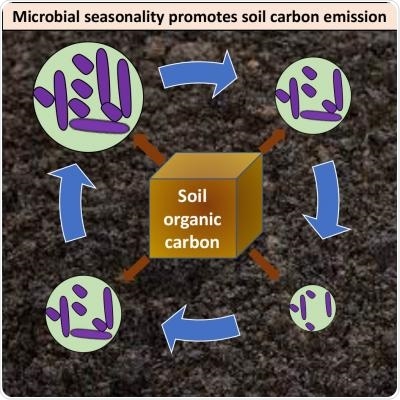The climate where we live affects our energy intake as humans. Humans expend more energy in climates where the weather varies from hot summers to extremely cold winters because the body needs to work harder to regulate temperature.

San Diego State University ecologists found that seasonal fluctuations in temperature lead to a corresponding fluctuation in soil microbial populations, and increased carbon emissions. Image Credit: San Diego State University.
Climate influences soil microbes like fungi and bacteria in the same way. Seasonal changes in moisture and soil temperature influence microbial activity, which in turn affects soil carbon emissions and nutrient cycles.
Microbes use carbon as an energy source. Microbes absorb more carbon as their quantities and actions increase, resulting in more carbon emissions and vice versa.
San Diego State University ecologists discovered that microbial seasonality has a major effect on global carbon emissions and serves as a fundamental mechanism that controls terrestrial-climate relationships and below-ground soil biogeochemistry in a modeling study recently published in Global Change Biology.
When microbial colonies in the soil are in a productive phase, increasing in numbers and size, they will need more carbon to fuel their growth. When we manipulated the quantities and activities of soil microbes in simulations and observed the reciprocal changes in soil carbon, we found that when seasonal variation was removed, microbial respiratory rates went down.”
Xiaofeng Xu, Study Lead Author and Global Change Ecologist, San Diego State University
Carbon emissions can be minimized by maintaining the microbial population at a steady average level. To reduce soil carbon emissions, land stewards may reduce fluctuation in soil microbial population by tillage and other management activities, according to the researchers. It may also assist agricultural scientists and farmers in maintaining soil fertility.
To reach this conclusion, Xu and collaborators used a microbial modeling framework called CLM-Microbe (Community Land Model) established in the Ecological Modeling and Integration Lab at SDSU, where he investigates how climate change affects the terrestrial carbon cycle and implemented the model on an SDSU supercomputer.
We know soil microbes drive carbon flux—the amount of carbon exchanged between land, ocean and atmosphere -- by producing enzymes that impact carbon flux. Soil carbon completes its cycle with the help of these microbes which have a hand in ultimate control of the carbon.”
Xiaofeng Xu, Study Lead Author and Global Change Ecologist, San Diego State University
Different microbial groups in the soil perform distinctive functions in the carbon cycle.
The model’s ability to simulate bacterial and fungal dynamics improves our understanding of the soil microbial community’s impact on the carbon cycle.”
Liyuan He, Study First Author and Doctoral Student, San Diego State University
The discovery advances soil microbial ecology by demonstrating the ecological importance of microbial seasonality as well as our knowledge of soil carbon accumulation under shifting climate conditions.
Carbon fluxes found at an individual plot scale in nine natural biomes were validated and modeled, namely, tundra, tropical/subtropical forest, temperate broadleaf forest, grassland, boreal forest, temperate coniferous forest, shrubland, grassland, desert, and wetland.
“This study demonstrates the need to incorporate microbial seasonality in earth system models so we can better predict climate-carbon interactions,” said Chun-Ta Lai, co-author and an ecosystem ecologist at SDSU.
Following that, the researchers will investigate microbial seasonality and its effect on global carbon balance, taking into account the dynamics of land-use transition around the world.
Source:
Journal reference:
He, L., et al. (2021) Microbial seasonality promotes soil respiratory carbon emission in natural ecosystems: A modeling study. Global Change Biology. doi.org/10.1111/gcb.15627.